Developing a Questionnaire for Measuring the Importance of Campus Sustainability Initiatives
Link to the JSE March 2024 General Issue Table of Contents
Parsley Liu Waliczek JSE March 2024 General Issue PDF
Abstract: The concept of sustainability has been gaining increasing attention worldwide, especially over the last 30 years. To foster sustainable development, education plays a crucial role. Higher education institutions have assumed the leading role in sustainability education and advocating sustainability. However, the literature that evaluates sustainability initiatives at higher education institutions is still fragmented and sparse, with existing studies often focusing on certain aspects of the sustainability initiatives. We designed a questionnaire that covers a broad spectrum of sustainability measures in the operation, curriculum, research, and outreach, which allowed us to investigate the perceived importance of those sustainability initiatives from the perspective of university community members including undergraduate students, graduate students, faculty, and staff at Texas State University in San Marcos. Our results indicated that the Texas State University campus community believes that the themes of Waste Management, Buildings & Infrastructure, and Water Use & Management were the most important themes. The campus community believed that Transportation and Academics are the least important themes. We also identified a set of action items under each theme the most and least important.
Keywords: Sustainability education, questionnaire design, recycling, waste management, composting, environmental science, environmental attitudes
Introduction
Since the 1987 United Nation’s Brundtland Report, the concept of sustainability has started to gain increasing global recognition. Education is among them. Higher education institutions (HEI) increasingly recognize their potential, and some have made strides to incorporate sustainable practices and initiatives into their education and daily operations (Berchin et al., 2021; Lozano et al., 2015; Ramos et al., 2015; Katiliŋtė et al., 2014; Lozano et al., 2013; Stephens & Graham, 2010). HEI has helped to shape the mindset and value systems of future decision-makers in society, and university campuses are places where college students develop habits and beliefs that they may take to their future lives (Washington-Ottombre et al., 2018; Waliczek et al., 2016; Lindholm, 2004). Operating and functioning independently as “micro-cities” within larger communities, college campuses are considered ideal learning laboratories to research and identify reasonable sustainability initiatives that meet the needs of society (Horhota et al., 2014). Meanwhile, sustainability initiatives at HEIs can make positive strides towards climate mitigation as university campus contribute up to 2% of the total annual United States greenhouse gas emissions (Sinha et al., 2010).
Starting from the groundwork on environmental education set by the United Nations Educational, Scientific and Cultural Organization (UNESCO 1977), academic communities have been putting forth various organizations that advocate sustainability engagement in HEIs in their operations and curricula (Lozano et al., 2013; Ceulemans et al., 2011; Shephard, 2008). A few examples of organizations include the Talloires Declaration (1990), the Halifax Declaration (1991), and Swansea Declaration (1993) (Herremans and Reid 2002) and the Association for the Advancement of Sustainability in Higher Education (AASHE). Signees to those declarations or members of these associations agree to establish educational programs that produce environmental literacy (The Talloires Declaration 1990), contribute to “major attitudinal and policy changes for a sustainable future” (The Swansea Declaration, 1993), and to inspire and catalyze higher education to lead the global sustainability transformation (AASHE 2023). As of 2021, about 520 universities and colleges from 55 nations signed the Tallories Declaration, among which 173 are from the United States. Based in the United States, AASHE attracts over 900 higher education institutions, businesses, and other nonprofit organizations members from the U.S. and Canada (AASHE 2023).
Over the past three decades since the Brundtland report, HEIs promote sustainability through improving environmental management, teaching and research, and community outreach and partnerships (Wright and Wilton, 2012; Evangelinos et al., 2009; Owens and Halfacre-Hitchcock, 2006; Bonnet et al., 2002; Delakowitz and Hoffmann, 2000). Environmental management practices aim to reduce university campus carbon footprints using practices on energy consumption, waste management, pollution prevention, and resource conservation. Using interdisciplinary and systemic approaches, research and teaching initiatives incorporate sustainability into curricula and transform students into agents for change (Wamsler, 2020; Evans and Graff, 2012; Ferreira et al., 2006). The community outreach and partnerships promote sustainability’s economic, social, and environmental dimensions in local communities through exchange programs, joint degrees with other universities, joint research, partnerships with external organizations, events open to the community (Lozano et al. 2015).
Numerous sustainability assessment tools or reporting systems have been created to evaluate those sustainability initiatives (Alonso-Almeida et al., 2014; Waheed et al., 2011) and the majority of them focus on North America (Larrán Jorge et al., 2016). The prominent system is the Sustainability Tracking, Assessment & Rating System (STARS) for HEI campuses developed by the AASHE. The STARS is a self-reporting system that covers the areas of university procurement, transportation, energy consumption, waste management practices, sustainable research development, sustainability in academic curriculum, building design, and much more (McNamara, 2008). Once reported, HEIs receive a score on how well their campuses are implementing sustainability programs and education into their operations and curriculum.
Analysis using the STARS data indicates that campus sustainability movement is quite young (Urbanski and Filho 2015) and that evaluation of HEI sustainability reporting systems are rather fragmented and sparse in existing literature (Sepasi et al. 2018; Ceulemans et al. 2014; Sánchez et al. 2013). Furthermore, very few studies examine stakeholders (faculty, staff, students) engagement although stakeholder engagement facilitate universities identifying more relevant aspects of the sustainability initiatives (Washington-Ottombre et al., 2018; Bellantuono et al., 2016; Ceulemans et al. 2015). This is becoming an emerging gap and can be an important obstacle to practicing sustainability (Ferrero-Ferrero et al. 2018; Washington-Ottombre et al., 2018; Leal Filho et al. 2017).
Our study contributes to the literature by providing a framework that measures the importance of HEI campus sustainability initiatives from the perspective of stakeholders. Using Texas State University in San Marcos as a case study, we developed a comprehensive questionnaire based on sustainability master plans and sustainability developmental plans from peer institutions and other institutions’ Campus Culture Assessments sourced from the AASHE database. We then administered our survey to the faculty, staff, graduate, and undergraduate students at Texas State University to gather their opinions on the importance of sustainability initiatives in the areas of Buildings & Infrastructure, Waste Management, Energy, Transportation, Water Use & Management, Grounds, Purchasing, Academics, and Campus Life. We hoped that our framework will help improve campus sustainability development plans and determine priority areas based on the engagement of stakeholders.
Methods
Study Area and Survey Approach
We adopted a focus group approach at Texas State University, San Marcos, TX. Located between Austin and San Antonio on the I-35 corridor, Texas State University has approximately 37,812 students, 1,470 full time faculty and 2,185 full time staff members (Texas State University, 2020). The student body is comprised of 33,193 undergraduate students, 461 post-baccalaureate students, 3,620 master’s students, and 538 doctoral students. The University has two campuses: the San Marcos campus (located in the city of San Marcos, TX) includes approximately 507 acres of land and Round Rock campus (located in north Austin, TX) sits on roughly 101 acres of land. The university has an additional 4,000 acres of academic, agricultural, research, and recreational areas (Texas State University, 2021).
Texas State University, the San Marcos campus, sits along the Balconies Escarpment between two ecoregions and is positioned in a unique environment within Central Texas. To the west of the San Marcos campus is the Edwards Plateau region which includes the recharge zone for the Edwards Aquifer and is made up of mostly limestone bedrock with rocky terrain and savannah like ecosystems. To the East of the San Marcos campus is the Blackland Prairie region which is comprised of clay-based soils and tall prairie grasses. The Round Rock campus is comprised of the Blackland Prairie ecoregion and is situated on less elevated terrain.
Questionnaire Design and Validation
The whole system approach of sustainability education is supposed to encompass the entire spectrum of HEIs’ operation including research, education and outreach (Koscielniak, 2014). However, existing literatures often focus on certain aspects of the sustainability measures including sustainable building and energy efficiency, water conservation, waste management, transportation, procurement, land use and planning (Adams et al., 2018; Huo and Yu, 2017; Yoshida et al., 2017; Cupido et al., 2016; Pacheco-Blanco and Bastante-Ceca 2016; Dagiliūtė and Liobikienė, 2015; Nejati and Nejati, 2013). Corresponding to the whole system approach, we designed a survey questionnaire that covers a broad spectrum of sustainability initiatives reflected in the sustainability master plans and sustainability developmental plans from peer institutions, in the STARS database sponsored by AASHE, and in the literature. The initiatives can be categorized into the following nine themes: 1) Buildings & Infrastructure, 2) Waste Management, 3) Energy, 4) Transportation, 5) Water Use & Management, 6) Grounds, 7) Purchasing, 8) Academics, and 9) Campus Life. The first seven themes focus on actions that turn university campuses greener, theme 8) covers sustainability education through curriculum building and education, while theme 9) focuses on outreach measures including faculty and student organizations, sustainability events etc.
Under each theme of sustainability initiatives, multiple statements were used to ask survey subjects for their opinion on the importance of various actions surrounding each theme from different angles (See Table 1 for the statement/actions under each theme)). We used a Likert scale ranging from “strongly agree” to “strongly disagree” or “extremely important” to “extremely unimportant” (Likert, 1932) with the most negative response scoring the lowest point of one and the most positive response scoring the highest points of five. The entire questionnaire resulted in a total score of 480 (96 statements total) possible points. Higher scores indicated a greater perception of importance for the sustainability measure while lower scores indicated a lower perception of importance.
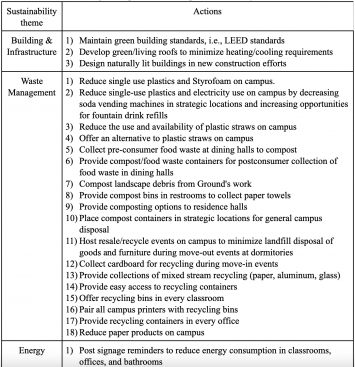
Table 1. Sustainability Actions under Each Sustainability Theme in the Study of Developing a Questionnaire for Measuring the Importance of Campus Sustainability Initiatives
Parsley Liu Waliczek Table 1: Full PDF
Additionally, we also included open-ended questions where respondents could enter their own thoughts and concerns. Open-ended responses provided more in-depth, qualitative data including opinions, critiques, and comments regarding individual experiences with sustainability issues and outcomes on campus. This data was organized and tabulated by developing themes, which included positive, negative, and neutral comments. Because survey subjects could give a mixture of answers, responses were often registered in more than one theme. These results were summarized by frequency of response by the various themes developed and double-checked with NVivo (NVivo 12, Melbourne, Australia).
Besides questions on the theme 1) – 9) on sustainability initiatives, questions were also incorporated to ask individual’s self-reported knowledge on sustainability, their interest in acquiring further knowledge on sustainability, and their perceptions of university efforts, commitment, and current achievement in promoting sustainability compared to peer institutions. We also asked our survey subjects their opinion on the importance of sustainability to a healthy society and its economic feasibility.
Questionnaire Validation and Survey Implementation
Experts’ review and a pilot study were implemented to check the internal validity of the questionnaire. The survey questionnaire draft was sent to Texas State’s Faculty Senate’s committee on Environment and Sustainability to check its face validity and approval. A pilot run was implemented during April 12 and May 3, 2021on a group of faculty, staff, and students via the members of the Texas State’s Faculty Senate group and the Environment & Sustainability committee. The pilot survey collected 44 responses and the initial analysis of the pilot survey data indicated a suitable Cronbach’s alpha reliability score of 0.983. The final version of the questionnaire was administered online via Qualtrics during May 5 to July 1, 2021.
We used a campus-wide email to recruit students, faculty, and staff. Participants were offered an opportunity of being entered into a drawing for a $100 gift card. Surveys were administered via QualtricsTM (Provo, UT) and it took approximately 10-15 min to complete the survey questionnaire. The survey questions and study were approved by the Texas State University Institutional Review Board (#7671). A total of 1,148 responses were received and among them 925 questionnaires were completed.
Table 2 presents the demographic characteristics of the survey respondents. The largest share of the respondents was female, accounting for 67% of our overall sample. This composition is consistent with our trend of university level gender composition with more than 60% female students and less than 40% male students. The largest share of respondents was the student body that consisted of undergraduate (34.7%) and graduate (10.6%) students followed by staff (39.4%) including administrative staff, graduate workers and research associates. The other 15.32% of respondents identified as faculty members of the university. Corresponding to our sample composition of students, faculty and staff, 33.4% of the participants were less than 25 years old. Among the students in our sample, more than 55% of sample individuals majored in social sciences, humanities, arts and/or related fields, 29% in science and engineering fields, and less than 10% in business and economic fields. This composition does not deviate too far from the university enrollment by major with 24.3% in science and engineering, 64.3% in social sciences, humanities and arts, and over 11.4% in business and economics.
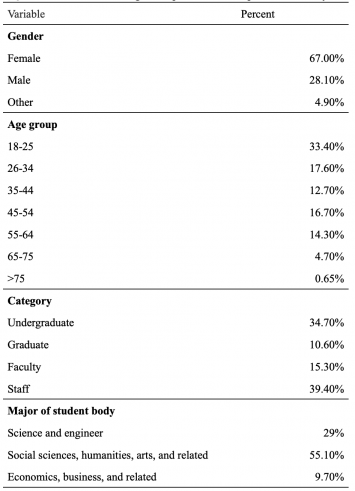
Table 2. The Demographic Characteristics of the Survey Respondents in the Study of Developing a Questionnaire for Measuring the Importance of Campus Sustainability Initiatives
Survey Assessment and Statistical Analysis
We used Factor Analysis (Harman 1976) to check the relationship of the questions under each of the nine categories of the sustainability initiatives and to identify if more than one underlying latent factor under a category might exist. FA is a statistical method that examines the variability among observed, correlated variables to determine the numbers of potentially unobserved variables called factors. Eigenvalues are calculated for each of the potential underlying factors that express the amount of variance a factor explains. If multiple latent factors have eigenvalues of 1 or above, it indicates that those factors explain more variance than the single observed theme. Thereby, we use a cutoff Eigenvalue of 1 in this study to determine the number of underlying latent factors for each of the themes. If a specific theme returned only one latent factor with Eigenvalue less than 1, we would be ensured that the questions within each sustainability category truly concentrated around the individual themes. If other results were produced, the themes would need to be further refined and split into more than one category.
We implemented the factor analysis for the entire sample of Texas State University community and our sub-sample of undergraduate students, graduate students, faculty, and staff separately. Our results indicated that most of the themes for the entire pooled university community had only one underlying factor. The only exception was the Waste Management theme (Theme 2), which returned 2 underlying factors. The results are consistent among both faculty and staff groups. For undergraduate students, Grounds (Theme 6) was the only one with more than one underlying factor. For graduate students, Waste Management (Theme 2) and Grounds (Theme 6) were the two themes that produced two underlying factors.
We conducted both a quantitative and qualitative analyses using SPSS™ (version 20.0; IBM Corp., Armonk, NY) and STATA. The qualitative analysis focused on open-ended questions and identified what area of sustainability receives more attention from the campus community. The quantitative analysis examined the rank of the sustainability themes and identified the actions that the university community values the most and the least.
Results
Individual Perception of Sustainability, Current Effort, and the Importance of Each Sustainability Theme
Our survey data indicates that 59% of campus members report that they are “somewhat educated” and “highly educated” on sustainability topics, while 84% of the surveyed individuals are interested in learning how to become a more sustainable individual. In total, 67% strongly agree that sustainability is imperative for supporting a healthy social structure in a community. When asked if the participants agreed or disagreed with statements regarding Texas State University and its relationship with sustainable development, faculty and students show slightly different opinions. Over 50% of students (both undergraduate and graduate) and staff reported that sustainability decisions should be economically feasible while only 41.4% of faculty strongly agreed. More than 15% of undergraduate students strongly agreed that Texas State University maintained sustainable initiatives comparable to peer institutions and acted as a sustainable model for the regional community, while less than 10% of graduate students, staff, and faculty members agreed.
Table 3 presents the mean score of perceived importance for each sustainability theme by the university community. Among all the nine themes, Waste Management is perceived as the most important followed by Building & Infrastructure and the Water Use & Management. Transportation theme received the least mean importance score. It is not a surprise that Waste Management was the most eye-catching topic. The term sustainability is often synonymous with the word environmentalism and recycling is often directly correlated with sustainable development (Speer et al., 2020).
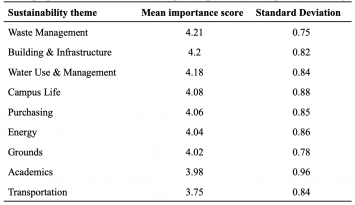
Table 3. Mean Score of Perceived Importance for Each Sustainability Theme in the Study of Developing a Questionnaire for Measuring the Importance of Campus Sustainability Initiatives
Highest and Lowest-Ranked Sustainability Initiatives under Each Theme
Our survey identifies for each sustainability theme the initiatives that the university community valued the most (in Table 4) and valued the least (in Table 5). Among all nine themes, Building & Infrastructure, Transportation, Academics, and Campus Life, all revealed similar responses from the Texas State community across students, faculty, and staff members. We believe this similarity in perceived importance of actions within those themes was due to these sectors being the ones that are most prevalent in daily life. Those daily interactions result in better understanding of the sustainable development initiatives taking place in those themes. One example is the sustainability theme of Campus Life, the initiative of “hosting and encouraging river clean up events”, is greatly supported across the campus community due to the university’s geographic location along the edge of a river. The San Marcos River is a precious resource for the university and a main attraction that brings people into the institution.
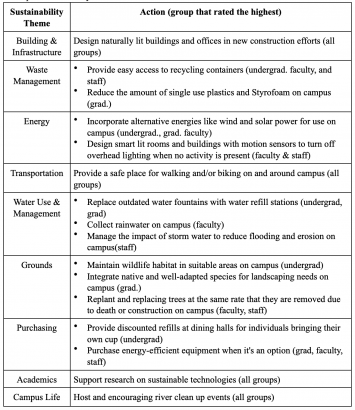
Table 4. Highest Rated “Extremely Important” Sustainability Actions by Campus Community by Sustainability Theme in the Study of Developing a Questionnaire for Measuring the Importance of Campus Sustainability Initiatives
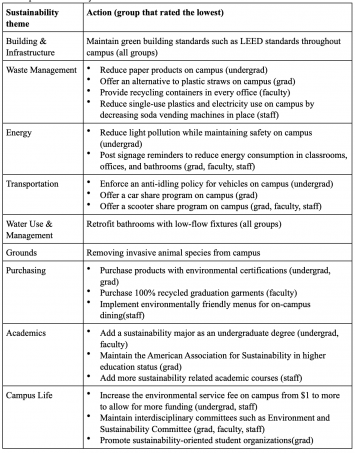
Table 5. Lowest Rated “Extremely Important” Action by Campus Community for each Sustainability Theme in the Study of Developing a Questionnaire for Measuring the Importance of Campus Sustainability Initiatives
Among those actions perceived as the most important, some have already been implemented. They include reducing the amount of single use plastics and Styrofoam on campus, designing smart lit rooms and buildings with motion sensors to turn off overhead lighting when no activity is present, managing the impact of storm water to reduce flooding and erosion on campus, purchasing energy-efficient equipment when it is an option, and hosting and encouraging river clean-up events.
Sustainability actions considered as the least important by all students, faculty, and staff are in the themes of Building & Infrastructure, Water Use & Management, and Grounds. One example includes “removing invasive animal species from campus,” within the Grounds theme. We believe this was rated less important because the campus community does not foresee invasive flora and fauna to be a threat to the local ecosystem due to a lack understanding regarding the severity invasive species have on the environment. Another example of an action considered by the university community as least important is, “maintaining green building standards such as LEED (Leadership in Energy and Environmental Design) standards throughout campus”, under the themes of Building & Infrastructure. We believe this less important rating is due to the lack of understanding of the LEED (Leadership in Energy and Environmental Design) standards and how this design strategy can impact daily building occupants and the overall environment. However, it is worth noting that respondents across all sectors ranked the statement, “designing naturally lit buildings and offices in new construction efforts,” as most important even though the strategy of designing naturally lit buildings and offices in new construction projects is part of the LEED building checklist. This realization supports the notion that the campus community does not fully understand what LEED is and what this design strategy entails.
Although perceived as least important actions, some also have been implemented. These include maintaining green building standards such as LEED throughout the campus, reducing the use and availability of plastic straws on campus, offering a scooter share program on campus, and purchasing products with environmental certifications; Green Seal, EPEAT, etc. We believe that the campus community does not see these strategies as a top priority due to subjective perceptions and due to a misunderstanding of what sustainability truly stands for because of the environmental science narrative that campus sustainability has been housed in and marketed as for the last couple of decades. This misunderstanding itself must be addressed in order to create a more holistic campus culture centered on sustainable development.
Qualitative Result from Open-Ended Questions
We received over 700 open-ended responses from the campus community. The open-ended responses were reviewed and divided into the nine sustainability themes based on their key phrases, statements, and/or words. Table 6 presents the key words that we use for each of the nine themes and the percentage of responses to open-ended questions that comment on a specific theme. The response stating “I Don’t Know” or “Room for improvement” are excluded from this analysis. For the responses that cover multiple themes, we split the responses and put each piece into their corresponding theme. Take the response of “high water and electric usage, gas powered leaf blowers, campus vehicles, and buses. Green rooftops would make a big difference, too’’ as an example. “High water and electric usage” was placed in the Energy theme since Texas State University relies on boiler steam plants and chiller plants for cooling and heating water and buildings across campus. The statement, “gas powered leaf blowers” was placed into the Grounds theme. “Campus vehicles and buses” was placed in the Transportation theme and “Green rooftops would make a big difference too” was placed in both the Building & Infrastructure theme and the Energy theme.
Most open-ended responses were geared towards the theme of Recycling & Waste Management (27.6%). This finding is consistent with the mean importance score in Table 3. The theme of Purchasing and Academics is the least mentioned among all themes with only 1.5% and less than 0.2% of the open-ended responses. We believe this is due to the misunderstanding that sustainability is synonymous with the terms “environmental” and “eco-friendly”.
Within each theme, we coded the responses into positive, neutral, or negative responses. For example, “I believe Texas State takes sustainability very seriously” and “recycling bins are plentiful” were marked positive. “Good focus on no littering, need more focus on renewable energy sources, composting, local foods” and “there is always room to improve” were marked neutral. “Lots of problems with student body,” “They promote sustainability but make us pay for it, making it classist and unobtainable for those with lower incomes,” “the recycling is very poorly setup” were marked negative. Overall, 47% (334 responses) of the responses are negative, 43% (302 responses) are neutral, and about 10% (73 responses) are positive.
A word cloud was generated to review the most used terms within the open response section of the survey. Words with larger font and deeper colors were recorded to be the most frequently used terms in these responses. The majority of statements included words such as sustain, campus, recycle, university, student, improvement, waste, building, water, and energy.
Conclusion and Discussion
HEIs and their university campuses are the places that shape the mindsets, value system, beliefs, and habits of future generations of decision-makers. As the concept of sustainability is infiltrating into every aspect of our lives, society increasingly expects HEIs to take the leading role in sustainability education and advocating sustainability. However, the sustainability movement at HEIs are still relatively young and significant knowledge gaps exist that can impede sustainability practices. A prominent gap is the sparse and fragmented evaluations of ongoing sustainability practices at university campuses, which focus only on certain aspects of sustainability measures. We contributed to the literature of sustainability education by developing a questionnaire that covers nine themes of sustainability initiatives in operations, curriculum, research, and outreach and evaluated the perceived importance of the initiatives among university communities.
We conducted our survey at Texas State University, San Marcos. Both quantitative and qualitative analyses were conducted using the survey data. The quantitative analysis indicated that Waste Management, Building & Infrastructure, Water Use & Management were the sustainability themes that undergraduate, graduate, faculty, and staff considered more important. We also identified within each theme the action that the university community considered most important and least important. Using qualitative analysis, we examined the answers to open-ended questions. We found that the majority of the open-ended responses were critiques on the existing sustainability efforts and the perceived important themes were related to waste management.
The results of this study will provide valuable insights into how the Texas State University campus community perceives sustainability initiatives for campus sustainable development. This data will also allow for campus stakeholders and campus planners to review specific initiatives that are not currently being executed to their fullest potential and where to locate potential bottlenecks. By identifying these bottlenecks, Texas State University’s key stakeholders will be able to address these issues, correct the information failure, and provide better and more holistic guidance in steering the campus community into a more sustainable future. A snapshot of examples of university initiatives and the related sustainability categories are outlined in Table 7 below.
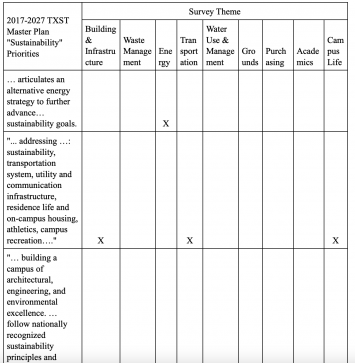
Table 7: Chart outlining examples of university initiatives and the corresponding sustainability categories
Parsley Liu Waliczek Table 7: Link to Full PDF
An example of a bottleneck and a specific initiative that is not currently being executed to its fullest potential involves the management of food waste produced on campus. Reducing food waste produced on campus will require permanent support and campus-wide implementation of the composting program because a large portion of waste produced on campus involves food matter. Also, waste produced on campus is tied to materials being purchased and used by the campus community such as cutlery, food boats, napkins, straws, plates, to-go boxes, etc. If these items were certified industrial compostable then they could also be disposed of in the organics bins and could be diverted from landfill. Ultimately, by doing so it will reduce the tonnage of mass waste all together and shrink the university’s carbon footprint.
However, the residing bottleneck is the lack of support and acknowledgement of the composting program. Currently the composting program is faculty managed by a single individual and is student operated and relies on grant funding, if awarded. If the composting program is expanded from a top-down approach and given the necessary attention such as full-time technicians and staffers, industrial equipment, and proper materials, then the program can be utilized campus-wide. This will require the university’s top administration to acknowledge the need for this service and to acknowledge that the campus community believes that Waste Management is one of the top sustainability priorities for the university.
One thing we would like to note is the potential impact of COVID-19 on the survey results. The survey took place during the pandemic when a considerable number of classes were only offered online. Remote learning can affect individual opinion, and even their perceived importance of a specific sustainability action or theme. This might explain why the theme of Academics only received 1.5% of the open-ended comments and both themes of Transportation and Academics were low in the importance ranking. In future studies, it would be worthwhile to conduct the survey again during post-pandemic period to check if community members perceptions change. Furthermore, we would also like to check further if the perceived importance of sustainability themes or actions differ statistically among different groups, what might cause the differences, and how this might apply to the priority of sustainability development among HEIs.
References
Adams, R. Martin, S. and Boom, K. (2018) University culture and sustainability: Designing and implementing an enabling framework. J. Clean. Prod., 171: 434-445, 10.1016/j.jclepro.2017.10.032
Alonso-Almeida, M.M., Marimon, F., Casani, F. and Rodríguez-Pomeda, J. (2015), “Diffusion of sustainability reporting in universities: current situation and future perspectives”, Journal of Cleaner Production 106(1):144-154.
Bellantuono, N., Pontrandolfo, P. and Scozzi, B. (2016), Capturing the Stakeholders’ View in Sustainability Reporting: A Novel Approach, Sustainability, 8(4), 379. https://doi.org/10.3390/su8040379
Berchin, I. I., de Aguiar Dutra, A. R., & Guerra, J. B. S. O. A. (2021). How do higher education institutions promote sustainable development? A literature review. Sustainable Development. 29 (6): 1204-1222. https://doi.org/10.1002/sd.2219
Bonnet, J.F., Devel, C., Faucher, P., Roturier J. (2002) Analysis of electricity and water end-uses in university campuses: case-study of the University of Bordeaux in the framework of the Ecocampus European Collaboration J. Clean. Prod., 10 (1): 13-24. http://dx.doi.org/10.1016/S0959-6526(01)00018-X
Brundtland, G. (1987). Report of the World Commission on Environment and Development: Our Common Future. United Nations General Assembly Document A/42/427.
Ceulemans, K., De Prins, M., Cappuyns, V., De Coninck W. (2011) Integration of sustainable development in higher education’s curricula of applied economics: large-scale assessments, integration strategies and barriers J. Manag. Organ., 17 (4): 621-640.
Ceulemans, K., Lozano, R. and Alonso-Almeida, M. del M. (2015), “Sustainability Reporting in Higher Education: Interconnecting the Reporting Process and Organisational Change Management for Sustainability”, Sustainability, Vol. 7 No. 7, pp. 8881–8903.
Cupido, A. Steinberg, L. and Baetz, B. (2016) Water conservation observations from a higher education facility management perspective. J. Green Build. 11 (3): 162-182, 10.3992/jgb.11.3.162.1
Dagiliūtė, R. Liobikienė G. (2015) University contributions to environmental sustainability: Challenges and opportunities from the Lithuanian case J. Clean. Prod., 108: 891-899, 10.1016/j.jclepro.2015.07.015
Delakowitz, B., Hoffmann A. (2000) The Hochschule Zittau/Görlitz: Germany’s first registered environmental management (EMAS) at an institution of higher education Int. J. Sustain. High. Educ., 1 (1):35-47. http://dx.doi.org/10.1108/1467630010307084
K.I. Evangelinos, N. Jones, E.M. Panoriou (2009) Challenges and opportunities for sustainability in regional universities: a case study in Mytilene, Greece J. Clean. Prod., 17 (12): 1154-1161.
Evans, J. and Graff, E. (2012), “Promoting environmental and cultural awareness through experiential learning”, International Journal of Sustainability Education, 8(1):151-160.
Ferreira, A.J.D., Lopes, M.A.R. and Morais, J.P.F. (2006), “Environmental management and audit schemes implementation as an educational tool for sustainability”, Journal of Cleaner Production, 14( 9-11): 973-982.
Ferrero-Ferrero I., Fernández-Izquierdo M.A., Muñoz-Torres M.J., Bellés-Colomer L. (2018) “Stakeholder engagement in sustainability reporting in higher education: An analysis of key internal stakeholders’ expectations”, International Journal of Sustainability in Higher Education, 19(2):313-336, https://doi.org/10.1108/IJSHE-06-2016-0116.
Harman, Harry H. (1976). Modern Factor Analysis. University of Chicago Press. pp. 175, 176. ISBN 978-0-226-31652-9.
Herremans, I. M., & Reid, R. E. (2002). Developing Awareness of the Sustainability Concept. The Journal of Environmental Education, 34(1), 16–20. doi:10.1080/00958960209603477
Horhota, M., Asman, J., Stratton, J. P., & Halfacre, A. C. (2014). Identifying behavioral barriers to campus sustainability: A multi-method approach. International Journal of Sustainability in Higher Education. 15(3): 343–358. doi:10.1108/ijshe-07-2012-0065
Huo, X. Yu, A.T. (2017) Analytical review of green building development studies. J. Green Build., 12 (2): 130-148, 10.3992/1943-4618.12.2.130
Koscielniak, C. (2014) A consideration of the changing focus on the sustainable development in higher education in Poland. J. Clean. Prod., 62: 114-119.
Larrán Jorge, M. Herrera Madueño, J. Calzado, Y. Andrades, J. (2016) A proposal for measuring sustainability in universities: a case study of Spain Int. J. Sustain. High Educ., 10.1108/IJSHE-03-2015-0055
Leal Filho, W., Wu, Y.-C. J., Brandli, L. L., Avila, L. V., Azeiteiro, U. M., Caeiro, S., & Madruga, L. R. da R. G. (2017) Identifying and overcoming obstacles to the implementation of sustainable development at universities, Journal of Integrative Environmental Sciences, 14(1), 93-108, http://dx.doi.org/10.1080/1943815X.2017.1362007
Likert, R. (1932). A Technique for the Measurement of Attitudes. Archives of Psychology, 140, 1–55.
Lindholm, J. A. (2004). Pathways to the professoriate: The role of self, others, and environment in shaping academic career aspirations. The Journal of Higher Education, 75(6), 603- 635.
Lozano, R., Lukman, R., Lozano, F., Huisingh, D., Lambrechts, W. (2013). Declarations for sustainability in higher education: becoming better leaders, through addressing the university system J. Clean. Prod., 16 (17):10-19.
Lozano, R., Ceulemans, K., Alonso-Almeida, M., Huisingh, D., Lozano, F. J., Waas, T., … Hugé, J. (2015). A review of commitment and implementation of sustainable development in higher education: Results from a worldwide survey. Journal of Cleaner Production, 108, 1–18. https://doi.org/10.1016/j.jclepro.2014.09.048
Lozano, R., Lukman, R., Lozano, F. J., Huisingh, D., & Lambrechts, W. (2013). Declarations for sustainability in higher education: Becoming better leaders, through addressing the university system. Journal of Cleaner Production, 48, 10–19. https://doi.org/10.1016/j.jclepro.2011.10.006
Katiliŋtė, E., Daunorienė, A., & Katkutė, J. (2014). Communicating the sustainability issues in higher education institutions World Wide Webs. Procedia Social and Behavioral Sciences, 156, 106–110. https://doi.org/10.1016/j.sbspro.2014.11.129
Krejcie, R.V. and Morgan, D.W. (1970). Determining Sample Size for Research Activities. Educational and Psychological Measurement, 30: 607-610.
McNamara, K.H. (2008). “Fostering sustainability in higher education: a mixed methods study of transformative leadership and change strategies”. PhD diss., in Leadership & Change Program, Antioch University.
Nejati, M. and Nejati M. (2013) Assessment of sustainable university factors from the perspective of university students. J. Clean. Prod., 48: 101-107, 10.1016/j.jclepro.2012.09.006
Owens, K.A., Halfacre-Hitchcock, A. (2006) As green as we think? The case of the College of Charleston green building initiative Int. J. Sustain. High. Educ., 7 (2): 114-128. http://dx.doi.org/10.1108/14676370610655904
Pacheco-Blanco, B. and Bastante-Ceca M.J. (2016) Green public procurement as an initiative for sustainable consumption. An exploratory study of Spanish public universities. J. Clean. Prod., 133: 648-656, 10.1016/j.jclepro.2016.05.056
Rammel, C., Velazquez, L., & Mader, C. (2015). Sustainability assessment in higher education institutions: what and how?. In Routledge handbook of higher education for sustainable development (pp. 355-370). Routledge.
Ramos, T. B., Caeiro, S., Hoof, B., Lozano, R., Huisingh, D., & Ceulemans, K. (2015). Experiences from the implementation of sustainable development in higher education institutions: Environmental Management for Sustainable Universities. Journal of Cleaner Production, 106, 3–10. https://doi.org/10.1016/j.jclepro.2015.05.110
Sánchez, R., Bolívar, M. and Hernández, A. (2013). “Online disclosure of university social responsibility: a comparative study of public and private US universities”, Environmental Education Research, 19: 709-746.
Sepasi, S., Braendle, U., & Rahdari, A. H. (2018). Comprehensive sustainability reporting in higher education institutions. Social Responsibility Journal. https://doi.org/10.1108/SRJ-01-2018-0009
Shephard, K. (2008). Higher education for sustainability: seeking affective learning outcomes Int. J. Sustain. High. Educ., 9 (1): 87-98.
Stephens, J. C., & Graham, A. C. (2010). Toward an empirical research agenda for sustainability in higher education: Exploring the transition management framework. Journal of Cleaner Production, 18, 611–618. https://doi.org/10.1016/j.jclepro.2009.07.009
Sinha, P., Schew, W. A., Sawant, A., Kolwaite, K. J., & Strode, S. A. (2010). Greenhouse gas emissions from US institutions of higher education. Journal of the Air & Waste Management Association, 60(5), 568-573.
Speer, J. H., Sheets, V., Kruger, T. M., Aldrich, S. P., & McCreary, N. (2020). Sustainability survey to assess student perspectives. International Journal of Sustainability in Higher Education. 21(6): 1151-1167. https://doi.org/10.1108/IJSHE-06-2019-0197
The Association for the Advancement of Sustainability in Higher Education (AASHE) https://www.aashe.org/ retrieved on Feb 1, 2023.
The Swansea Declaration. (1993, August). Association of Commonwealth Universities Quinquennial Conference, University of Wales. Swansea. Wales.
The Talloires Declaration. (1990, October). Retrieved February 1. 2023. From http://www.ulsf.org/programs-talloires-report.html
Texas State University. “Facts & Data.” Brand Guidelines: Texas State University. Available online: https://www.txstate.edu/research/ord/funding/texas-state-information (accessed on 12 Jan. 2021).
Texas State University. “University Demographics.” Office of Institutional Research: Texas State University. Available online: www.ir.txstate.edu/highlights/highlights-demographics (accessed on 28 Feb. 2020).
Urbanski, M., Filho, W.L. (2015). Measuring sustainability at universities by means of the Sustainability Tracking, Assessment and Rating System (STARS): early findings from STARS data. Environ Dev Sustain 17, 209–220. https://doi.org/10.1007/s10668-014-9564-3
Waheed, B., Khan, F., Veitch, B. and Hawboldt, K. (2011). “Uncertainty-based quantitative assessment of sustainability for higher education institutions”, Journal of Cleaner Production, (19):720-732.
Waliczek, T., McFarland, A., & Holmes, M. (2016). The relationship between a campus composting program and environmental attitudes, environmental locus of control, compost knowledge, and compost attitudes of college students. HortTechnology, 26(5),592-598.
Wamsler, C. (2020). Education for sustainability: Fostering a more conscious society and transformation towards sustainability. International Journal of Sustainability in Higher Education, 21(1), 112–130. https://doi.org/10.1108/IJSHE-04-2019-0152.
Washington-Ottombre, C., Washington, G. L., & Newman, J. (2018). Campus sustainability in the US: Environmental management and social change since 1970. Journal of Cleaner Production, 196:564-575.
Wright, T. and Wilton H. (2012). Facilities management directors’ conceptualizations of sustainability in higher education J. Clean. Prod., 31:118-125.
Yoshida, Y. Shimoda, Y. Ohashi, T. (2017). Strategies for a sustainable campus in Osaka university Energy Build., 147:1-8, 10.1016/j.enbuild.2017.04.0







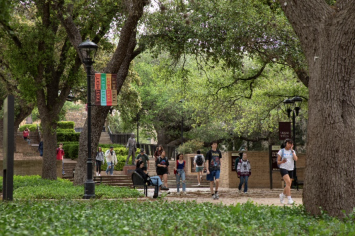
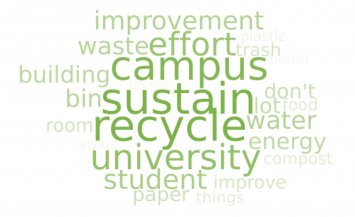



 Emma Corinne Parsley was a graduate Student within the Department of Sustainability Studies and is the Sustainability Coordinator for Texas State University.
Emma Corinne Parsley was a graduate Student within the Department of Sustainability Studies and is the Sustainability Coordinator for Texas State University.  Xiangping Liu is an assistant professor of Agricultural, Resource, and Environmental Economics at Department of Agricultural Sciences, Texas State University.
Xiangping Liu is an assistant professor of Agricultural, Resource, and Environmental Economics at Department of Agricultural Sciences, Texas State University.  Tina Marie Waliczek is a professor of horticulture at Department of Agricultural Sciences, Texas State University.
Tina Marie Waliczek is a professor of horticulture at Department of Agricultural Sciences, Texas State University. 
